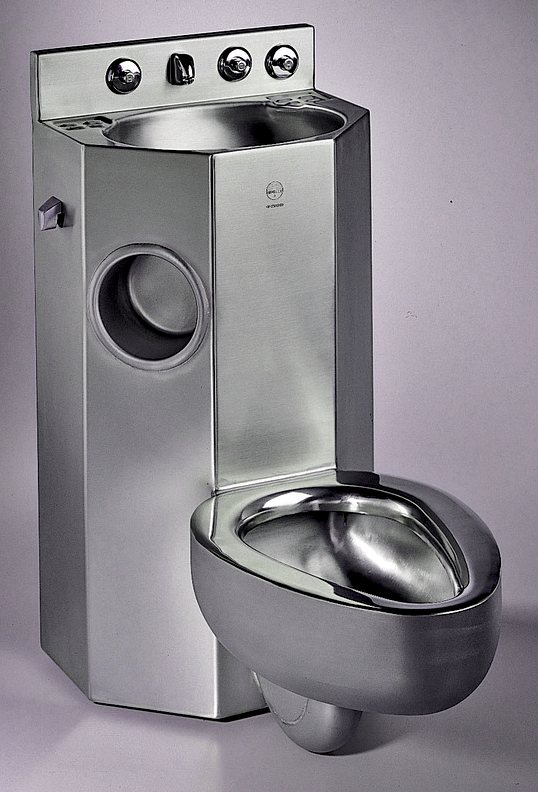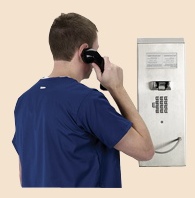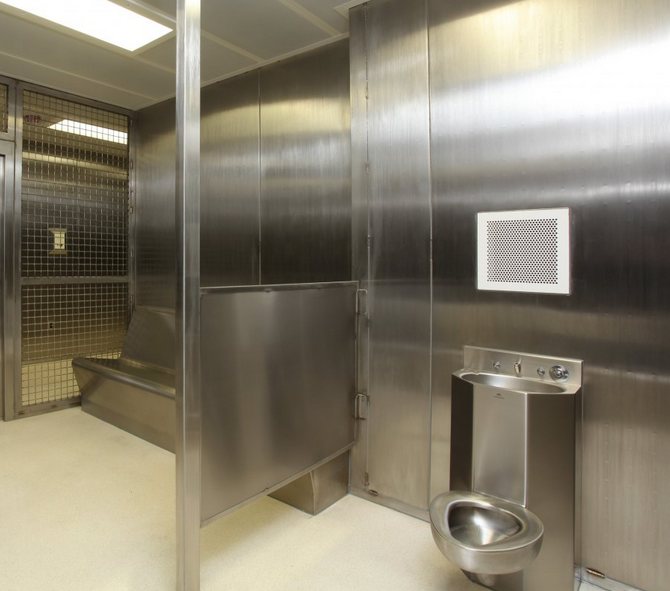 A former inmate sizes up detention products, #1 in a casual series.
A former inmate sizes up detention products, #1 in a casual series.
It’s a dubious distinction, I know, but I’ve been among the first 75 inmates to enter a brand new prison. The place hadn’t been “officially” opened yet, and it wasn’t even entirely complete. In fact, it took months before the technological marvel it was said to be actually began to function as designed. My memoir, Where Excuses Go to Die, can tell you more about that story; today we’re simply going to look at some of the design elements and corrections products that represent modern incarceration in America.
 I bring up my own experience because, in the absence of a boisterous and threatening prison population, I actually had the luxury of appreciating the punitive design genius behind shelving, inmate phones, door hinges, mattresses, linens, flooring, high pressure laminate table tops, mirrors, hooks and hardware, and so forth – almost as if they’d been displayed in an art gallery. It was spooky and (relatively) wonderful.
I bring up my own experience because, in the absence of a boisterous and threatening prison population, I actually had the luxury of appreciating the punitive design genius behind shelving, inmate phones, door hinges, mattresses, linens, flooring, high pressure laminate table tops, mirrors, hooks and hardware, and so forth – almost as if they’d been displayed in an art gallery. It was spooky and (relatively) wonderful.
Imagine an essentially empty prison, almost entirely free of brutality, toothless Yard apes, and the white power hoo ha they blabber on about. It didn’t last, of course, but I treasured it while it did. Throughout the following year, inmates and staffers recognizing each other from that quieter time enjoyed something of a secret handshake, as if we were a step above unappreciative newcomers. It made eye contact and common goals a bit easier for us both to reach.
At any rate, whether you take your first custody turd in a prison cell, a county jail, or a police substation, sitting on your first steel pot will make you wonder what sadist invented such an uncomfortable throne.
 And you’ll have countless occasions to ponder this. My own musings roamed from diabolical designers to the sales techniques that ultimately convinced our facility administrators to buy the horrible things. I did, after all, have the advantage of seeing them as they appeared in brochures, before they became truly hideous.
And you’ll have countless occasions to ponder this. My own musings roamed from diabolical designers to the sales techniques that ultimately convinced our facility administrators to buy the horrible things. I did, after all, have the advantage of seeing them as they appeared in brochures, before they became truly hideous.
I could just hear the upsell: “You want the wall-hang or the floor mount? The blowout jet or siphon jet? You’re definitely gonna wanna add on the socket-niche for a roll of toilet paper! Now, our suicide-resistant models use about 2 gallons of water per flush, but the drain openings are smaller and tend to overfill. We can widen ’em for you, but it won’t be long before inmates realize they can fit a hand in there and start hiding stuff…”
So who is out there, upselling prison?
Well, there’s CharmTex, makers of the anti-suicide sleep sack, for one. Let’s listen in on their pitch:
“Inmates on suicide watch need to sleep too, and with this product, they can sleep comfortably, while you won’t have to constantly worry about them ripping off a strip of vinyl from a mattress or tearing up a sheet or even a blanket and hanging themselves with it.”
 Constantly worry? Who’s worried? No front-line custody personnel I ever saw worried about such things! And never mind the implied coziness of the sales literature: whatever this thing is made out of, no way is it comfortable to sleep in.
Constantly worry? Who’s worried? No front-line custody personnel I ever saw worried about such things! And never mind the implied coziness of the sales literature: whatever this thing is made out of, no way is it comfortable to sleep in.
But who convinces custody officials to have their holding cell benches sprayed with sound-deadening insulation in order to keep the “volume to a minimum” when the benches are “forcibly struck by arms and legs”? Well, in the case of the Shh! Bench (my name), that would be Kane Architectural Innovations, “Guardians of Safe Environments.”
 Kane offers civilian commercial property developers and prison wardens alike ornamental fabrications, fencing, decorative accent systems, window protection, sun shades, and a slew of mounting solutions. They do all of this with the conviction that, in today’s world, “unpredictable has become the norm.”
Kane offers civilian commercial property developers and prison wardens alike ornamental fabrications, fencing, decorative accent systems, window protection, sun shades, and a slew of mounting solutions. They do all of this with the conviction that, in today’s world, “unpredictable has become the norm.”
It is, by far, the greatest upsell closer ever conceived. Can’t you hear it?
“Look, Bob, your Board can do what it wants on these louvered windows, but building and business model be damned: bath salt crazies and Muslims could swarm your lobby any ‘ol Monday morning. Oh, they’re comin’. And if your vandalism screens and window louvers aren’t made by Kane, you’re putting pregnant staffers at risk.”
Not that Kane reps are this crass (though wouldn’t some of ‘em have to be?), but having been on the receiving end of their trade, I can assure you that this is an industry whose best interest is not served by the current national dialogue on sentence reform. It’s an industry that prefers to keep things like the “Kids for Cash” scandal, which shed light on some of its ugly, for-profit detention practices, quiet. It’s also an industry dependent on grim statistics like California’s having built 1 university since 1980, versus 30 prisons.
So here’s a look at a few more products from Kane and other prison product suppliers…
 Kane’s 13-gauge steel “Vantage Barrier” is a thick mesh fencing often used for interior hallway partitions and exterior recreation roofing. It looks great ‘til it traps so much dust that the upper reaches fill with particulates and start closing off light. Meanwhile, on the Yard, mid-air bird poops explode upon impact with the barrier, showering fellas below with a white rain that makes even the meanest Yard ape jiggle and dance like Dora the Explorer.
Kane’s 13-gauge steel “Vantage Barrier” is a thick mesh fencing often used for interior hallway partitions and exterior recreation roofing. It looks great ‘til it traps so much dust that the upper reaches fill with particulates and start closing off light. Meanwhile, on the Yard, mid-air bird poops explode upon impact with the barrier, showering fellas below with a white rain that makes even the meanest Yard ape jiggle and dance like Dora the Explorer.
 And forget inhospitable steel toilets, Kane’s line of custody “modesty panels” are both ineffective and insulting. They’re offered for “safety and privacy” and upsold to detention administrators as if inmates can afford to be shy. So here’s a cost-cutting tip: Don’t buy these! There’s no privacy in crowded holding cells; modesty is moot where feces gets smeared on walls; and safety? Really? From whom, predators too big to slip under the panel, too small to step over it, or too dumb to go around? (Answer: yes.)
And forget inhospitable steel toilets, Kane’s line of custody “modesty panels” are both ineffective and insulting. They’re offered for “safety and privacy” and upsold to detention administrators as if inmates can afford to be shy. So here’s a cost-cutting tip: Don’t buy these! There’s no privacy in crowded holding cells; modesty is moot where feces gets smeared on walls; and safety? Really? From whom, predators too big to slip under the panel, too small to step over it, or too dumb to go around? (Answer: yes.)
 Then there’s the Ranger Security Big B.O.S.S. II, the latest Body Orifice Security Scanner – because walk-through metal detectors don’t always zero in on razor blades keestered in the anus. The upsell here is the foot pedestal detection sensor, but plain old tickling works too well with toe-hiders to justify the extra cost. Besides, do you really want to know which employees are foot fetishists?
Then there’s the Ranger Security Big B.O.S.S. II, the latest Body Orifice Security Scanner – because walk-through metal detectors don’t always zero in on razor blades keestered in the anus. The upsell here is the foot pedestal detection sensor, but plain old tickling works too well with toe-hiders to justify the extra cost. Besides, do you really want to know which employees are foot fetishists?
Now don’t get me wrong: just ’cause we’re having a little fun with this stuff doesn’t mean it isn’t necessary, effective, or in some cases, appropriate. At $12,000 the B.O.S.S. II is also a bit overpriced, but such products do have their place. I’m not sure what the plan is to guard against heroin burritos, but I bet that upsell will be announced soon.
 In the meantime, from American Detention Suppliers, I bring you the G-BIB-2000 Isolation Bed. At $2246.85, the G-Bib has everything you need – unless you want your prisoner to stay put, in which case you’re gonna have to add the proprietary strap kit to your purchase. Those’ll dent your budget by another $399.85 for the polyurethane kit, and a whopping $752.85 for good old-fashioned leather. And you’re already paying $203.85 for a foam pad – ha!
In the meantime, from American Detention Suppliers, I bring you the G-BIB-2000 Isolation Bed. At $2246.85, the G-Bib has everything you need – unless you want your prisoner to stay put, in which case you’re gonna have to add the proprietary strap kit to your purchase. Those’ll dent your budget by another $399.85 for the polyurethane kit, and a whopping $752.85 for good old-fashioned leather. And you’re already paying $203.85 for a foam pad – ha!
Look, no phrase is repeated more behind bars than “If I was in charge” (and that includes the old chestnut, “I didn’t do it”). I must’ve said hundreds of times that, if I was in charge, I’d shop elsewhere. Humane Restraint, Inc., for instance, offers a backboard not unlike those used by paramedics – at half the price. The upsell straps are less than $50 a set, which means the pillow option can stay on the table. Plus you have the ability to stand a guy up in a closet, a real bonus for overcrowded prisons.
 In this golden age of detention supply profits, every other company out there wants to sell, sell, and upsell – some more brazenly than others. Across a lot of years of watching this emerging market, I’ve seen only one company set its marketing tone by what some would consider a humanitarian issue.
In this golden age of detention supply profits, every other company out there wants to sell, sell, and upsell – some more brazenly than others. Across a lot of years of watching this emerging market, I’ve seen only one company set its marketing tone by what some would consider a humanitarian issue.
ICS Jail Supplies, Inc. out of Waco, Texas, is a small, family business unafraid of addressing big and potentially off-putting topics. For instance, its home page asks, “Is Your Facility P.R.E.A. Compliant? We can help you get there.”

![]() Huh? In 2003, Congress passed the Prison Rape Elimination Act (P.R.E.A.), under which the Prison Rape Elimination Commission develops and maintains national standards to “prevent, detect, and respond to prison rape.” As much as I like to keep things light, it’s hard to forget waking up in the middle of the night to men screaming ‘cause they’re being held down somewhere nearby. And of the many detention suppliers out there, ICS is the only one to go near the uncomfortable reality that rape occurs behind bars on a minute-to-minute basis.
Huh? In 2003, Congress passed the Prison Rape Elimination Act (P.R.E.A.), under which the Prison Rape Elimination Commission develops and maintains national standards to “prevent, detect, and respond to prison rape.” As much as I like to keep things light, it’s hard to forget waking up in the middle of the night to men screaming ‘cause they’re being held down somewhere nearby. And of the many detention suppliers out there, ICS is the only one to go near the uncomfortable reality that rape occurs behind bars on a minute-to-minute basis.
 If I were in charge, if I had to fill a prison with toilets and beds, I wouldn’t want to think about an epidemic of rape. Likewise, if I were a detention vendor, I wouldn’t rub the terrible specter of prison rape in the faces of my potential customers. Other vendors rely on social responsibility officers: ICS hangs its social credibility right out on its commercial shingle.
If I were in charge, if I had to fill a prison with toilets and beds, I wouldn’t want to think about an epidemic of rape. Likewise, if I were a detention vendor, I wouldn’t rub the terrible specter of prison rape in the faces of my potential customers. Other vendors rely on social responsibility officers: ICS hangs its social credibility right out on its commercial shingle.
 I guess it could be argued that ICS is playing P.R.E.A. compliance to its own gain. But I spoke with two of the women who run the place, and I could tell neither saw me coming. Small or large, any business truly exploiting a humanitarian issue for profit is well prepared for questions from the public. These ladies weren’t. Turns out ICS offers surveillance products that reduce blind spots and, ideally, minimize assaults. It’s nothing earth shattering, but there’s clearly a market need.
I guess it could be argued that ICS is playing P.R.E.A. compliance to its own gain. But I spoke with two of the women who run the place, and I could tell neither saw me coming. Small or large, any business truly exploiting a humanitarian issue for profit is well prepared for questions from the public. These ladies weren’t. Turns out ICS offers surveillance products that reduce blind spots and, ideally, minimize assaults. It’s nothing earth shattering, but there’s clearly a market need.
Given the sheer number of detention vendors out there – from those who do good while profiting to those who tantalize goon squads with tactical gear – the unanswered question really is, What do our prisons say about us?
Maybe it’s time to examine the very idea of buildings we fill with humans and handcuffs. For a fascinating look at structures that “should not have been built,” listen as Jim Mueller, architect with KMD (the firm that designed Pelican Bay State Prison), discusses Ethical Standard 1.4 of the American Institute of Architects (AIA) at 99% Invisible.

